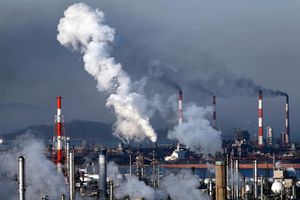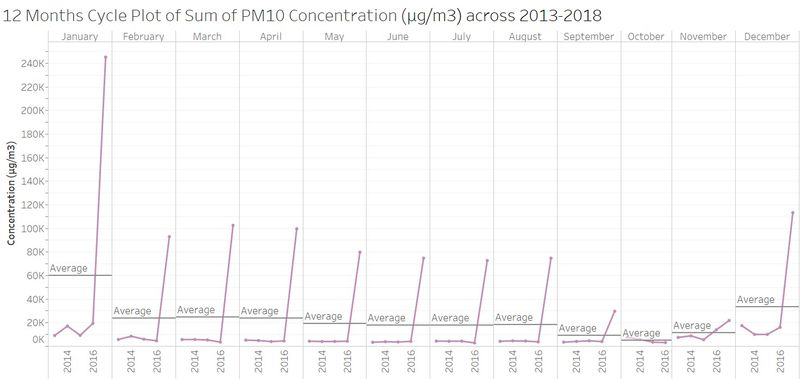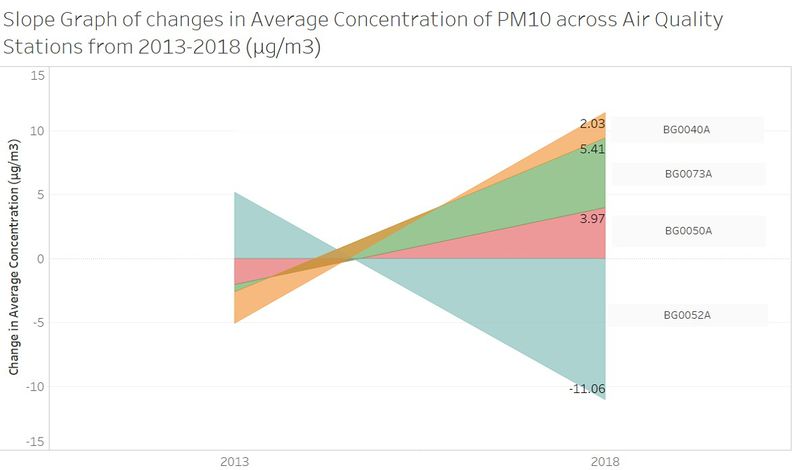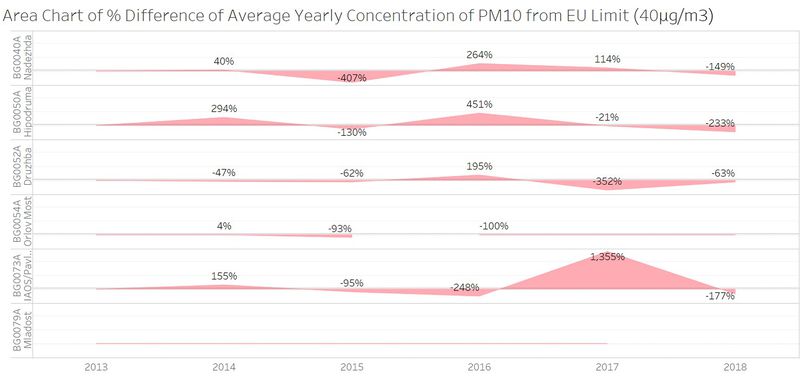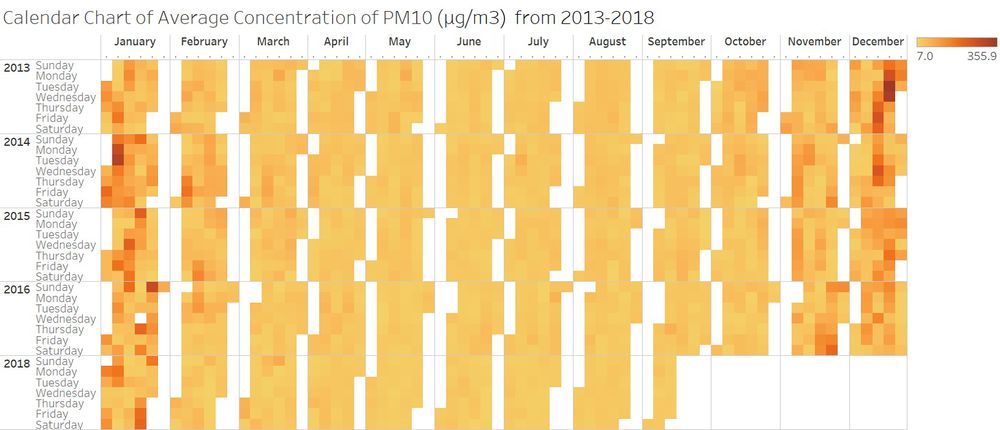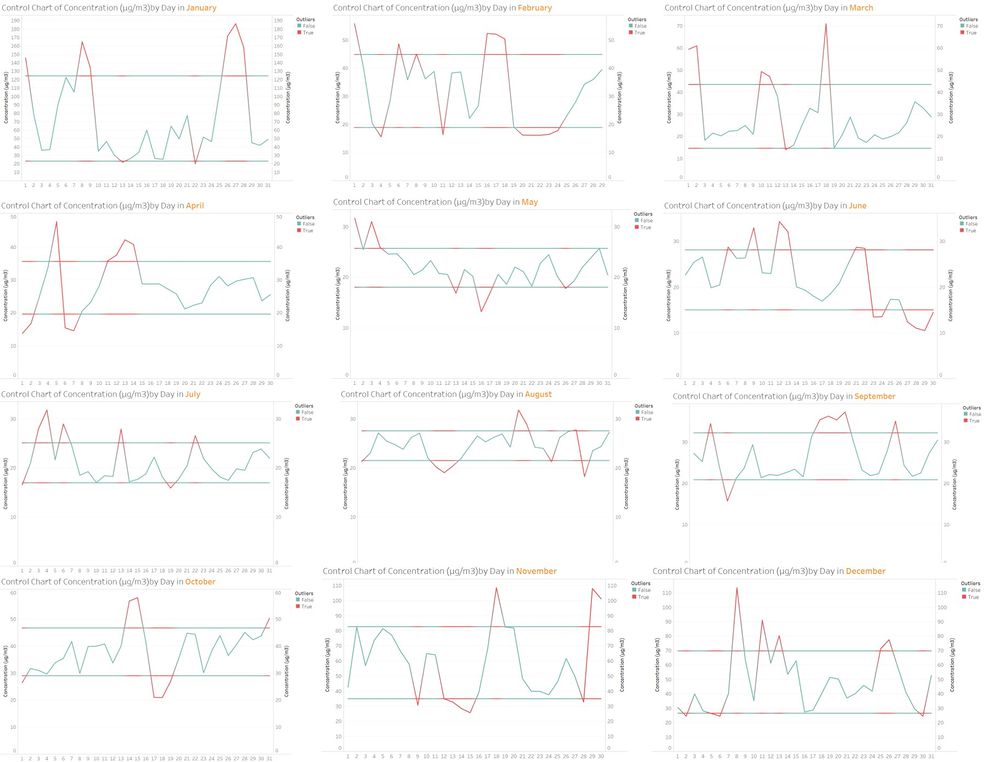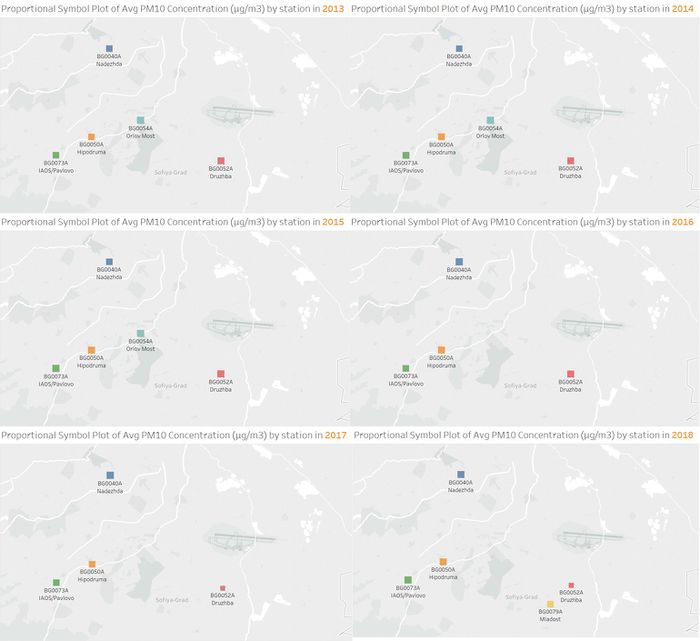Difference between revisions of "Task 1: Official Air Quality"
Yqchia.2017 (talk | contribs) |
Yqchia.2017 (talk | contribs) |
||
| (39 intermediate revisions by the same user not shown) | |||
| Line 11: | Line 11: | ||
| style="font-family:Century Gothic; font-size:100%; solid #1B338F; background:#173654; text-align:center;" width="20%" | | | style="font-family:Century Gothic; font-size:100%; solid #1B338F; background:#173654; text-align:center;" width="20%" | | ||
; | ; | ||
| − | [[Sofia City: Data Preparation| <font color="#f4f6f7">Data Preparation</font>]] | + | [[Sofia City: Data Preparation| <font color="#f4f6f7">Data Preparation & Dashboard</font>]] |
| style="font-family:Century Gothic; font-size:100%; solid #1B338F; background:#173654; text-align:center;" width="20%" | | | style="font-family:Century Gothic; font-size:100%; solid #1B338F; background:#173654; text-align:center;" width="20%" | | ||
; | ; | ||
| − | [Task 1: Official Air Quality | + | [[Task 1: Official Air Quality| <font color="#f4f6f7">Task 1</font>]] |
| style="font-family:Century Gothic; font-size:100%; solid #1B338F; background:#173654; text-align:center;" width="20%" | | | style="font-family:Century Gothic; font-size:100%; solid #1B338F; background:#173654; text-align:center;" width="20%" | | ||
| Line 30: | Line 30: | ||
|} | |} | ||
<br/> | <br/> | ||
| + | <font size="4">'''Spatio-temporal Analysis of Official Air Quality'''</font> | ||
| − | == | + | ==Comparison of Past and Present Air Quality Situation in Sofia== |
| + | Characterize the past and most recent situation with respect to air quality measures in Sofia City. What does a typical day look like for Sofia city? <br/> | ||
| − | + | === Changes from 2013 to 2018 === | |
| − | |||
| − | |||
| − | + | [[File:Cycleplot1.jpg|800px|frameless|left]] | |
| − | |||
| − | |||
| − | |||
| − | |||
| − | |||
| − | |||
| − | |||
| − | |||
| − | |||
| − | |||
| − | |||
| − | |||
| − | |||
| − | |||
| − | |||
| − | |||
| − | == | + | |
| + | |||
| + | |||
| + | |||
| + | |||
| + | |||
| + | |||
| + | |||
| + | |||
| + | |||
| + | |||
| + | |||
| + | |||
| + | '''While there is an overall increasing trend from 2013-2018, the greatest increase in PM10 concentration is recorded in January'''<br/> | ||
| + | The 12 month Cycle Plot visualizes the changes in sum of annual concentration of PM10 from 2013-2018 at a monthly basis. We noticed that while there is a overall increasing trend in concentration across all months from 2013-2018, the greatest increase can be seen in the month of January and December. Noticebly in January 2018, there is a record sum of concentration of PM10 of 245320 (µg/m3). <br/> | ||
| + | |||
| + | |||
| + | [[File:Slope graph1.jpg|800px|frameless|left]]<br/> | ||
| + | |||
| + | |||
| + | |||
| + | |||
| + | |||
| + | |||
| + | |||
| + | |||
| + | |||
| + | |||
| + | |||
| + | |||
| + | |||
| + | |||
| + | |||
| + | |||
| + | |||
| + | |||
| + | |||
| + | |||
| + | |||
| + | |||
| + | |||
| + | |||
| + | |||
| + | |||
| + | |||
| + | |||
| + | |||
| + | |||
| + | |||
| + | |||
| + | |||
| + | '''With exception of Druzhba, all other stations recorded increase in average annual PM10 concentration from 2013-2018'''<br/> | ||
| + | Taking in consideration of incomplete data point from 2013-2018 for Orlov Most and Mladost, we can plot the slope graph of changes in average concentration of PM10 (µg/m3) for the remaining 4 stations. While the cycle plot enables us to have an appreciation of the changes in pollutant concentration over the years by month, the slope graph allow us to compare the movement in concentration level across individual stations from 2013-2018. We can see that with the exception of Druzhba which recorded a decrease of -11.06 (µg/m3) in 2018 as compared to the average annual concentration across 2013-2018, the rest of the stations all recorded an increase in pollutant concentration across the years.<br/> | ||
| + | |||
| + | |||
| + | |||
| + | [[File:Area.jpg|800px|frameless|left]]<br/> | ||
| + | |||
| + | |||
| + | |||
| + | |||
| + | |||
| + | |||
| + | |||
| + | |||
| + | |||
| + | |||
| + | |||
| + | |||
| + | |||
| + | |||
| + | |||
| + | |||
| + | |||
| + | |||
| + | |||
| + | |||
| + | |||
| + | |||
| + | |||
| + | |||
| + | |||
| + | |||
| + | '''Annual Average Concentration of PM10 frequently exceeds the EU allowable limit'''<br/> | ||
| + | The European Union sets the limit of 40 μg/m3 as the maximum annual average for PM10. When plotting a horizon graph, we were able to discern the percentage difference of the annual average concentration level across various stations throughout 2013-2018. The shaded area above/below the x-axis reflects the percentage difference which the annual average concentration deviates from the EU annual limit (40 μg/m3). | ||
| + | Most notably, the highest annual average concentration level was recorded in 2017 at BG0073A where average concentration level exceeded EU annual limits by 1355%.<br/> | ||
| + | |||
| + | === A typical day in Sofia City === | ||
| + | |||
| + | |||
| + | [[File:Calendar chart.jpg|1000px|frameless|left]] | ||
| + | |||
| + | |||
| + | |||
| + | |||
| + | |||
| + | |||
| + | |||
| + | |||
| + | |||
| + | |||
| + | |||
| + | |||
| + | |||
| + | |||
| + | |||
| + | |||
| + | |||
| + | |||
| + | |||
| + | |||
| + | |||
| + | |||
| + | |||
| + | |||
| + | |||
| + | |||
| + | |||
| + | |||
| + | |||
| + | |||
| + | |||
| + | |||
| + | '''Average Concentration of PM10 increases during winter seasons'''<br/> | ||
| + | This phenomenon is captured in a calendar chart where period of higher concentration of PM10 is represented with darker shade of color. We observed that the period of higher concentration is reflected in the winter seasons (January-December) across 2013-2018. Coincidentally, the concentration level during the summer season (May-July) is much lower as shown with lighted gradient of colors across all years. We will proceed to further investigate if pollutant concentration has a relationship with seasonality and climate in Task 3.<br/> | ||
| + | |||
| + | |||
| + | |||
| + | [[File:Control chart.jpg|1000px|frameless|left]]<br/> | ||
| + | |||
| + | |||
| + | |||
| + | |||
| + | |||
| + | |||
| + | |||
| + | |||
| + | |||
| + | |||
| + | |||
| + | |||
| + | |||
| + | |||
| + | |||
| + | |||
| + | |||
| + | |||
| + | |||
| + | |||
| + | |||
| + | |||
| + | |||
| + | |||
| + | |||
| + | |||
| + | |||
| + | |||
| + | |||
| + | |||
| + | |||
| + | |||
| + | |||
| + | |||
| + | |||
| + | |||
| + | |||
| + | |||
| + | |||
| + | |||
| + | |||
| + | |||
| + | |||
| + | |||
| + | |||
| + | |||
| + | |||
| + | |||
| + | |||
| + | |||
| + | |||
| + | |||
| + | |||
| + | |||
| + | '''No significant trends in daily concentration level of PM10'''<br/> | ||
| + | A control chart enables user to monitor changes in the level of pollutant concentration when it exceeds the norm i.e. standard deviation. For this visualization, we plot the daily changes in average concentration of PM10 on a monthly basis across all years. From the plot we can conclude there is no direct correlation between the day and week of the month with pollutant concentration.<br/> | ||
| + | |||
| + | ==Discovered Trends of Interest== | ||
| + | |||
| + | ===Anomalies in dataset=== | ||
| + | |||
| + | [[File:PSP1.jpg|700px|frameless|left]] | ||
| + | '''Missing dataset for STA-BG0054A from 2016-2018'''<br/> | ||
| + | Data from STA-BG0054A (Orlov Most) is missing from 2016-2018. This could be possible decommissioning of the air quality station from 2016 onwards. | ||
| + | |||
| + | |||
| + | '''New Air Quality Station in 2018 – STA- BG0079A (Orlov Most)'''<br/> | ||
| + | Dataset for Orlov Most covers only the first 9 months of 2018. | ||
| + | |||
| + | |||
| + | '''Incorrect altitude level for STA-BG0079A (Mladost)'''<br/> | ||
| + | In the metadata table provided, we noticed that altitude for STA-BG0079A (Mladost) set as “0” is likely to be an error as Sofia city sits at 550m above sea level. | ||
Latest revision as of 21:57, 19 November 2018
|
|
|
|
|
|
|
Spatio-temporal Analysis of Official Air Quality
Contents
Comparison of Past and Present Air Quality Situation in Sofia
Characterize the past and most recent situation with respect to air quality measures in Sofia City. What does a typical day look like for Sofia city?
Changes from 2013 to 2018
While there is an overall increasing trend from 2013-2018, the greatest increase in PM10 concentration is recorded in January
The 12 month Cycle Plot visualizes the changes in sum of annual concentration of PM10 from 2013-2018 at a monthly basis. We noticed that while there is a overall increasing trend in concentration across all months from 2013-2018, the greatest increase can be seen in the month of January and December. Noticebly in January 2018, there is a record sum of concentration of PM10 of 245320 (µg/m3).
With exception of Druzhba, all other stations recorded increase in average annual PM10 concentration from 2013-2018
Taking in consideration of incomplete data point from 2013-2018 for Orlov Most and Mladost, we can plot the slope graph of changes in average concentration of PM10 (µg/m3) for the remaining 4 stations. While the cycle plot enables us to have an appreciation of the changes in pollutant concentration over the years by month, the slope graph allow us to compare the movement in concentration level across individual stations from 2013-2018. We can see that with the exception of Druzhba which recorded a decrease of -11.06 (µg/m3) in 2018 as compared to the average annual concentration across 2013-2018, the rest of the stations all recorded an increase in pollutant concentration across the years.
Annual Average Concentration of PM10 frequently exceeds the EU allowable limit
The European Union sets the limit of 40 μg/m3 as the maximum annual average for PM10. When plotting a horizon graph, we were able to discern the percentage difference of the annual average concentration level across various stations throughout 2013-2018. The shaded area above/below the x-axis reflects the percentage difference which the annual average concentration deviates from the EU annual limit (40 μg/m3).
Most notably, the highest annual average concentration level was recorded in 2017 at BG0073A where average concentration level exceeded EU annual limits by 1355%.
A typical day in Sofia City
Average Concentration of PM10 increases during winter seasons
This phenomenon is captured in a calendar chart where period of higher concentration of PM10 is represented with darker shade of color. We observed that the period of higher concentration is reflected in the winter seasons (January-December) across 2013-2018. Coincidentally, the concentration level during the summer season (May-July) is much lower as shown with lighted gradient of colors across all years. We will proceed to further investigate if pollutant concentration has a relationship with seasonality and climate in Task 3.
No significant trends in daily concentration level of PM10
A control chart enables user to monitor changes in the level of pollutant concentration when it exceeds the norm i.e. standard deviation. For this visualization, we plot the daily changes in average concentration of PM10 on a monthly basis across all years. From the plot we can conclude there is no direct correlation between the day and week of the month with pollutant concentration.
Discovered Trends of Interest
Anomalies in dataset
Missing dataset for STA-BG0054A from 2016-2018
Data from STA-BG0054A (Orlov Most) is missing from 2016-2018. This could be possible decommissioning of the air quality station from 2016 onwards.
New Air Quality Station in 2018 – STA- BG0079A (Orlov Most)
Dataset for Orlov Most covers only the first 9 months of 2018.
Incorrect altitude level for STA-BG0079A (Mladost)
In the metadata table provided, we noticed that altitude for STA-BG0079A (Mladost) set as “0” is likely to be an error as Sofia city sits at 550m above sea level.
